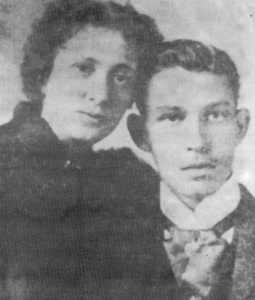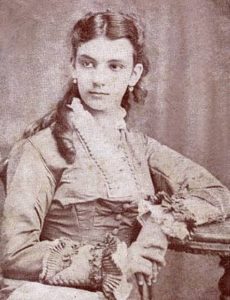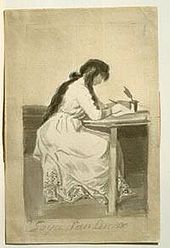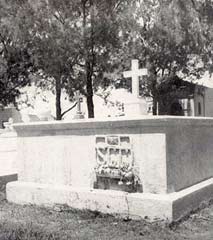 “LA NIÑA DE GUATEMALA” Y JOSÉ MARTÍ: A FORBIDDEN LOVE.
“LA NIÑA DE GUATEMALA” Y JOSÉ MARTÍ: A FORBIDDEN LOVE.
Jose Martí came to Guatemala at age 24 from Mexico, where he had professional success as a journalist and writer and had reunited with his family after his deportation from Spanish Cuba (1871-1875). In Guatemala he met the dramatic actress Eloisa Agüero and eventually got engaged to his future wife, Carmen Zayas Bazan.
Upon arriving to Guatemala he wrote a critical view of the inferiority that women had been subject to in that country: in an article entitled ‘The new codes “, published in Progreso, on April 22, 1877 he made the following reflection upon request of Joaquin Macal -Secretary of Foreign Affairs of Guatemala at the time-: “What is the first of the colonial ballasts from the deposed legislation? The absolute power that bestial husbands had over the venerable wife; it practically gives husbands parental rights over women. The law of heaven, is not capable of knowing the law of land?” So he focused on the Guatemalan ladies’ walking indolent, glances caste, dressed as women of the village, with braids lying on the mantle, they call shawl; hand counting idle floating mantle tips infant joys or sorrows of his first mistress’; that’s when he found Maria Gracia Granados.
Martí was known in Guatemala as “Doctor Torrente” due to his great speaking ability and charisma and also taught María at the Central American Academy for Girls June 1877, months after his arrival in this Central American nation in March 1877.
María García Granados y Saborío born June 6, 1860, also known as ‘La Niña de Guatemala’ (“the little girl of Guatemala”), was a Guatemalan socialite, daughter of General Miguel García Granados, who was President of Guatemala from 1871 to 1873 and whose house served as a gathering for the top artists and writers of the time. María was also niece and granddaughter of María Josefa García Granados, an influential poet and journalist of the time. When Cuban poet and patriot José Martí came to Guatemala in 1877, he was invited to General Garcia Granados gatherings and fell in love with Maria there, but could not correspond her because he was already engaged to marry Ms. Carmen Zayas Bazán.
Maria was more cosmopolitan and illustrated than the most of the ladies Martí met in Guatemala and he was immediately infatuated with her. It should be noted that it appears that María was not the standard shy and vulnerable Guatemalan girl: Guatemalan publications of the time talk about her relatively active participation as a musician and singer outside her home, in public artistic activities organized by societies and institutions where she coincided with Martí. Apparently she was a very popular youth within the city’s high society of the time; María was then the footsteps of her aunt and grandmother Maria Josefa, who had died in 1848 and had been a superb poet and journalist, very influential in the Conservative governments of Guatemala.
Love at first sight.
According a friend, M.B. Martínez: “She was a young interesting. I took Martí to a costume ball, that occurred in the García Granados household, two days after [first] arriving to Guatemala; we were both standing in one of the beautiful lounges, watching couples parade [when we saw coming] arm in arm two ladies sisters. Martí then asked me: “Who’s that girl dressed like an Egyptian?” “It is Maria, daughter of General” [I said]. Then, I gallantly stopped her and introduced her to my friend and countryman Martí, and electrical sparks ignited”]
José María Izaguirre:” She was tall, slender and graceful: her hair was black as ebony, rich, crisp and smooth as silk; her face -without being supremely beautiful- was sweet and friendly; her deep black and melancholic eyes, veiled by long lashes, revealed an exquisite sensitivity. Her voice was gentle and harmonious, and their ways so gentle, it was not possible to treat her without falling in love for her. She also played piano admirably, and when her hand slipped with abandonment by the keyboard, she poured out notes that seemed out of her soul and impress her listeners’ Jose Maria Izaguirre, a Cuban who lived in Guatemala at the time was principal of the then highly prestigious Central National High School for Boys and had appointed Marti as professor of literature and composition exercises. Besides dealing with teaching activities, Izaguirre, organized artistic and literary evenings which Martí attended frequently.It was there where he met Maria on April 21, 1877: then a gracious teenager, seven years younger than him.
In late 1877, Martí went to Mexico and returned until early next year, already married to Carmen. What happened after his marriage and return has been commented at length by those who witnessed the incident and by generations of Guatemalan and Cuban intellectuals afterwards.
Death and Legend
A small message that María sent to the Cuban when he returned married from Mexico..
‘Six days ago you came back to Guatemala, and you have not come to see me yet. Why? Do not delay your visit; I do not hold a grudge against you, because you always talked honestly about your situation and your moral commitment to marry Miss Zayas Bazán. I beg you to come soon’.
Your Niña.
On May 10, 1878 María García Granados y Saborio died, which would lead to a sad tale inspired by the frustrated love between the Cuban poet and national hero José Martí and her. That was shortly after learning that Martí had married, and he immortalized her in his 1891 poem ‘La Niña de Guatemala’. In a letter to his friend Manuel Mercado in which Marti painfully remembered María. Martí wrote: “And to think I sacrificed poor thing, María, for Carmen, who has climbed the stairs of the Spanish consulate to beg for protection from me.”. Marti hinted in his Poema IX something more sinister than death from sadness: allegorically, he implies the suicide of the rejected lover:
AND THE POEM END.
.. the one who died of love..
Poem IX (READ ORIGINAL IN THE SPANISH SECTION)
The Legend.
The legend originated as a result of a straight interpretation of the poem. Although it persists, there is no documented evidence of sufficient weight able to prove that María García Granados attempted against her own life or even died product of a depressive psychological state. An interview with a descendant of the García Granados family, sheds light on the family version -transmitted by oral tradition- that says that María, although with a cold, agreed to go swimming with her cousin, which was usual for them, perhaps to distract herself from the sadness in which she was plunged after the return of Martí. After the ride, María’s condition worsened and she died from a disease of the airways that she was already suffering.
At that time José María Izaguirre, for example, wrote.. “When Martí returned with Carmen he did not return to the general’s house, for the feeling was deeply rooted in María’s soul, and she was of those that easily forget. Her passion was locked in this dilemma: be satisfied, or die. Unable to get the first, he had only the second option left. Indeed, her nature was declining gradually, a continuous sigh consumed, and despite the care of the family and the efforts of science, after staying a few days in bed without uttering a complaint, her life extinguished like the scent of a lily ”
Legends about her grave.
It has been reported that even before the placement of the plaque in Maria’s Tomb, this was one of the most visited in the Cemetery, especially by young Guatemalan ladies asking for her help in matters of love. They also told reporters stories about the apparitions of a sad looking young lady asking that Maria’s grave should be decorated with flowers.
 “LA NIÑA DE GUATEMALA “Y JOSÉ MARTÍ: UN AMOR PROHIBIDO.”
“LA NIÑA DE GUATEMALA “Y JOSÉ MARTÍ: UN AMOR PROHIBIDO.”
José Martí llegó a Guatemala a los 24 años de México, donde tuvo éxito profesional como periodista y escritor y se había reunido con su familia después de su deportación de la Cuba española (1871-1875). En Guatemala conoció a la actriz dramática Eloisa Agüero y finalmente se comprometió con su futura esposa, Carmen Zayas Bazán.
Al llegar a Guatemala escribió una visión crítica de la inferioridad a la que las mujeres habían estado sometidas en ese país: en un artículo titulado ‘Los nuevos códigos’, publicado en Progreso, el 22 de abril de 1877 hizo la siguiente reflexión a petición de Joaquín. Macal -Secretario de Relaciones Exteriores de Guatemala en su momento-: “¿Cuál es el primero de los balastos coloniales de la legislación depuesta? El poder absoluto que los maridos bestiales tenían sobre la venerable esposa; prácticamente le da a los esposos derechos de paternidad sobre las mujeres. La ley del cielo, ¿no es capaz de conocer la ley de la tierra? “Así que se concentró en las mujeres guatemaltecas que caminaban indolentes, casta de miradas, vestidas como mujeres del pueblo, con trenzas sobre el manto, llaman chal, contando las manos manto flotante ocioso consejos infantes alegrías o tristezas de su primera amante ‘; fue entonces cuando encontró a Maria Gracia Granados.
Martí era conocido en Guatemala como “Doctor Torrente” debido a su gran habilidad para hablar y su carisma, y también le enseñó a María en la Academia Centroamericana de Niñas en junio de 1877, meses después de su llegada a esta nación centroamericana en marzo de 1877.
María García Granados y Saborío, nacida el 6 de junio de 1860, también conocida como “La Niña de Guatemala”, fue una joven guatemalteca, hija del General Miguel García Granados, quien fue Presidente de Guatemala desde 1871 hasta 1873 y cuya casa sirvió como una reunión para los mejores artistas y escritores de la época. María también era sobrina y nieta de María Josefa García Granados, influyente poeta y periodista de la época. Cuando el poeta y patriota cubano José Martí llegó a Guatemala en 1877, fue invitado a las reuniones del general García Granados y se enamoró de María allí, pero no pudo corresponderla porque ya estaba comprometido para casarse con la Sra. Carmen Zayas Bazán.
María era más cosmopolita e ilustrada que la mayoría de las damas que Martí conoció en Guatemala y se enamoró de ella inmediatamente. Cabe señalar que parece que María no era la típica guapa tímida y vulnerable guatemalteca: las publicaciones guatemaltecas de la época hablan de su participación relativamente activa como músico y cantante fuera de su hogar, en actividades artísticas públicas organizadas por sociedades e instituciones donde ella coincidió con Martí. Aparentemente ella era una joven muy popular dentro de la alta sociedad de la ciudad de la época; María fue entonces la huella de su tía y abuela María Josefa, que había muerto en 1848 y había sido una excelente poeta y periodista, muy influyente en los gobiernos conservadores de Guatemala.
Amor a primera vista.
Según un amigo, M.B. Martínez: “Ella era una joven interesante. Llevé a Martí a un baile de disfraces, que ocurrió en la casa de García Granados, dos días después de [la primera] llegada a Guatemala; ambos estábamos de pie en una de las hermosas salas, observando el desfile de parejas [ cuando vimos venir] manos entrelazadas a dos señoras hermanas. Martí entonces me preguntó: “¿Quién es esa chica vestida como una egipcia?” “Es María, hija del general” [dije]. Entonces, la paré valientemente y le presenté a mi amigo y compatriota Martí, y las chispas eléctricas se encendieron “]
Según un amigo, José María Izaguirre: “Era alta, esbelta y elegante: su cabello era negro como el ébano, rico, nítido y suave como la seda; su rostro -sin ser supremamente bello- era dulce y amigable, sus ojos negros y melancólicos, velados por largas pestañas, revelaban una exquisita sensibilidad. Su voz era suave y armoniosa, y sus maneras tan suaves, no era posible tratarla sin enamorarse de ella. También tocaba el piano admirablemente, y cuando su mano se deslizaba con abandono por él En el teclado, ella derramó notas que parecían estar fuera de su alma e impresionó a sus oyentes. José María Izaguirre, un cubano que vivía en Guatemala en ese momento era director de la entonces altamente prestigiosa Escuela Central Nacional de Muchachos y había nombrado a Martí como profesor de ejercicios de literatura y composición. Además de las actividades docentes, Izaguirre organizó veladas artísticas y literarias a las que Martí asistía con frecuencia. Allí fue donde conoció a María el 21 de abril de 1877: luego una graciosa adolescente, siete años menor que él.
A fines de 1877, Martí fue a México y regresó hasta principios del próximo año, ya casado con Carmen. Lo que sucedió después de su matrimonio y su retorno ha sido comentado en detalle por aquellos que fueron testigos del incidente y por generaciones de intelectuales guatemaltecos y cubanos después.
Muerte y leyenda
Un pequeño mensaje que María le envió al cubano cuando regresó casado de México.
-Hace seis días regresaste a Guatemala y aún no has venido a verme. ¿Por qué? No demore su visita; No guardo rencor contra usted, porque siempre habló honestamente sobre su situación y su compromiso moral de casarse con la señorita Zayas Bazán. Te ruego que vengas pronto ‘.
Tu Niña.
El 10 de mayo de 1878 muere María García Granados y Saborio, lo que llevaría a un triste relato inspirado en el amor frustrado entre el poeta cubano y el héroe nacional José Martí y ella. Eso fue poco después de saber que Martí se había casado, y la inmortalizó en su poema de 1891 “La Niña de Guatemala”. En una carta a su amigo Manuel Mercado en la que Martí recordaba dolorosamente a María. Martí escribió: “Y pensar que sacrifiqué a la pobre, María, por Carmen, que ha subido las escaleras del consulado español para pedirme protección”. Martí insinuó en su Poema IX algo más siniestro que la muerte por tristeza: alegóricamente, implica el suicidio del amante rechazado:
A la Niña de Guatemala.
Quiero, a la sombra de un ala,
contar este cuento en flor:
la niña de Guatemala,
la que se murió de amor.
Eran de lirios los ramos;
y las orlas de reseda
y de jazmín; la enterramos
en una caja de seda…
Ella dio al desmemoriado
una almohadilla de olor;
él volvió, volvió casado;
ella se murió de amor.
Iban cargándola en andas
obispos y embajadores;
detrás iba el pueblo en tandas,
todo cargado de flores…
Ella, por volverlo a ver,
salió a verlo al mirador;
él volvió con su mujer,
ella se murió de amor.
Como de bronce candente,
al beso de despedida,
era su frente -¡la frente
que más he amado en mi vida!…
Se entró de tarde en el río,
la sacó muerta el doctor;
dicen que murió de frío,
yo sé que murió de amor.
Allí, en la bóveda helada,
la pusieron en dos bancos:
besé su mano afilada,
besé sus zapatos blancos.
Callado, al oscurecer,
me llamó el enterrador;
nunca más he vuelto a ver
a la que murió de amor.
La leyenda.
La leyenda se originó como resultado de una interpretación directa del poema. Aunque persiste, no hay evidencia documentada de peso suficiente capaz de demostrar que María García Granados intentó en contra de su propia vida o incluso murió producto de un estado psicológico depresivo. Una entrevista con un descendiente de la familia García Granados, arroja luz sobre la versión familiar -transmitida por la tradición oral- que dice que María, aunque con resfriado, aceptó ir a nadar con su prima, lo que era habitual para ellos, tal vez para distraerse ella misma por la tristeza con que la hundieron después del regreso de Martí. Después del viaje, el estado de María empeoró y murió a causa de una enfermedad de las vías respiratorias que ya estaba sufriendo.
En ese momento José María Izaguirre, por ejemplo, escribió … “Cuando Martí regresó con Carmen, no regresó a la casa del general, porque el sentimiento estaba profundamente enraizado en el alma de María, y ella era de los que fácilmente olvidan. Su pasión era encerrado en este dilema: estar satisfecho o morir. Incapaz de obtener el primero, solo le quedaba la segunda opción. De hecho, su naturaleza disminuía gradualmente, se consumía un suspiro continuo y, a pesar del cuidado de la familia y los esfuerzos de la ciencia Después de permanecer unos días en la cama sin decir una queja, su vida se extingue como el aroma de un lirio “.
Leyendas sobre su tumba.
Se ha informado que incluso antes de la colocación de la placa en la Tumba de María, esta fue una de las más visitadas en el Cementerio, especialmente por las jóvenes guatemaltecas que le pedían ayuda en asuntos de amor. También contaron a los periodistas historias sobre las apariciones de una jovencita triste que pedía que la tumba de María estuviera decorada con flores.
Agencies/Wiki/Various/Internet Photos/ Excerpts/ YouTube/ Arnoldo Varona/ TheCubanHistoery.com
THE CUBAN HISTORY, HOLLYWOOD.












